




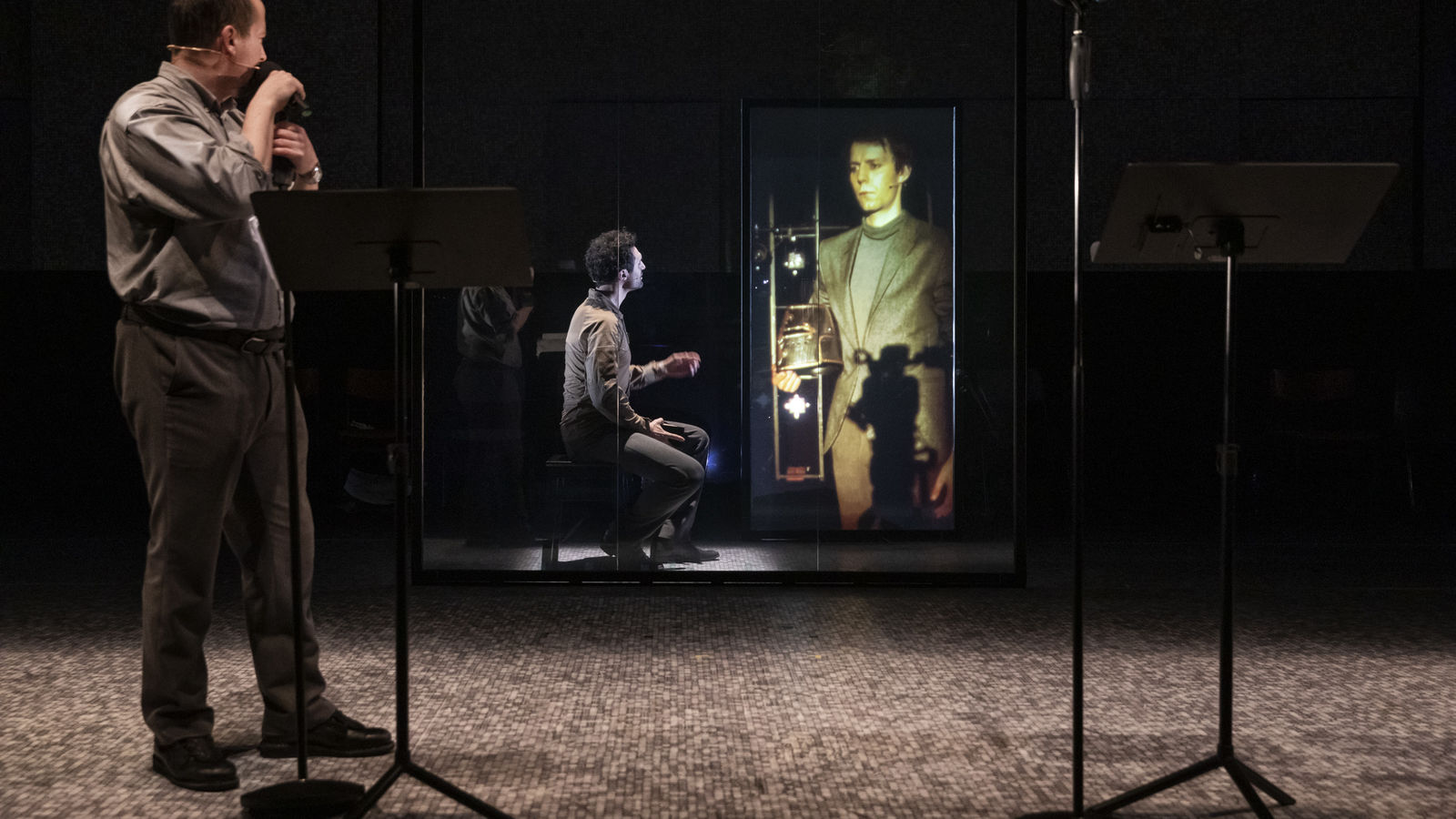
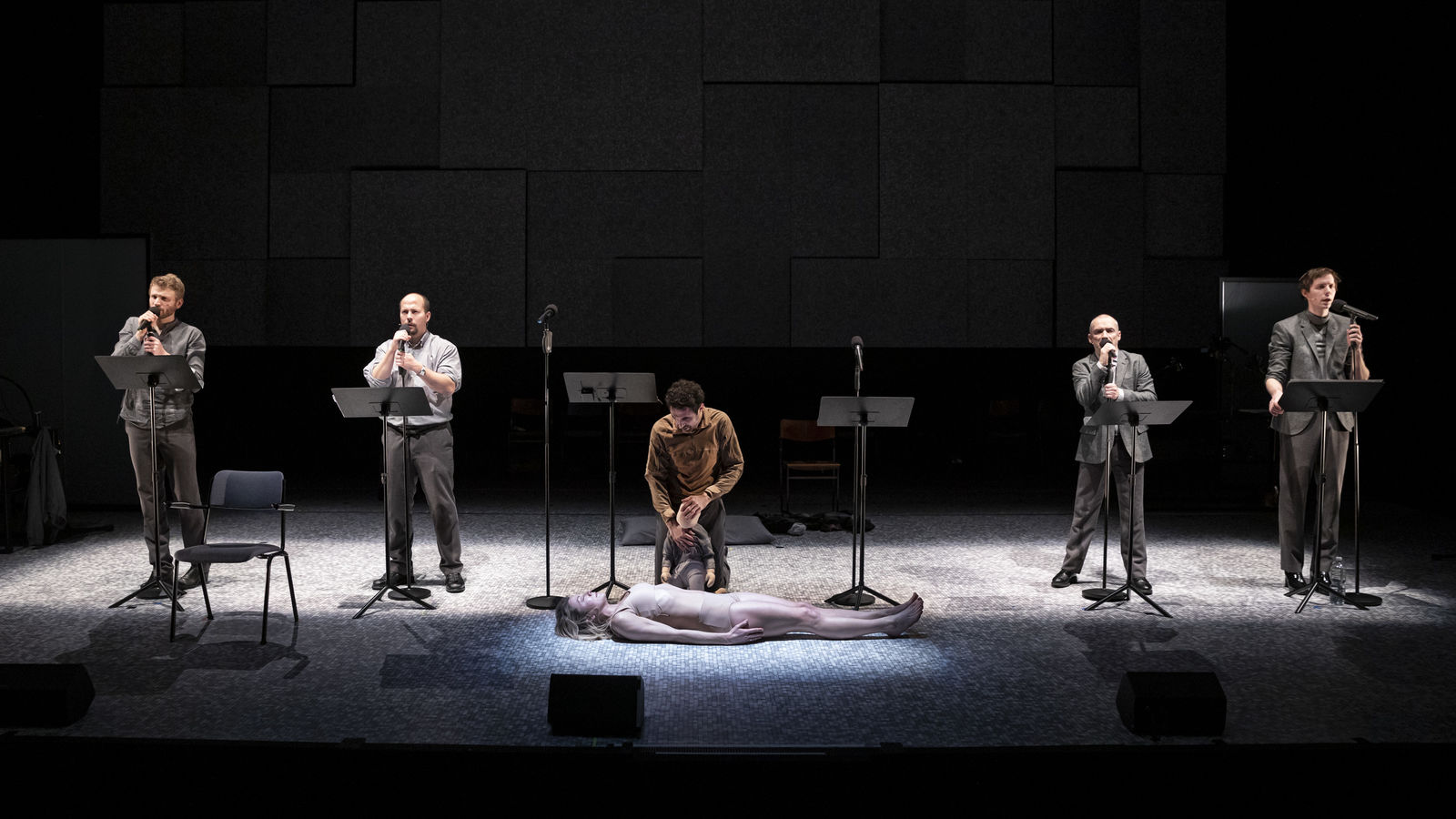


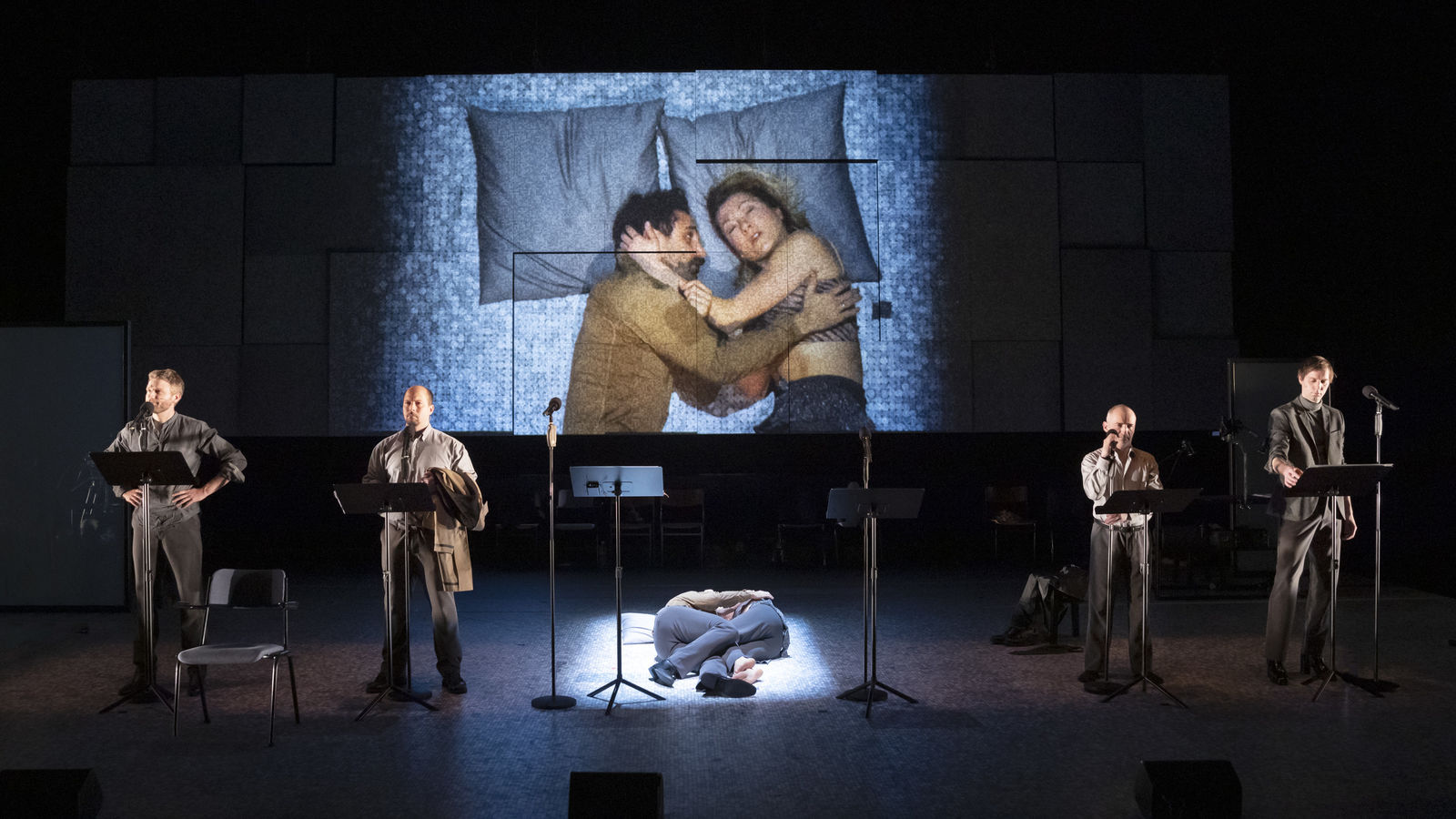

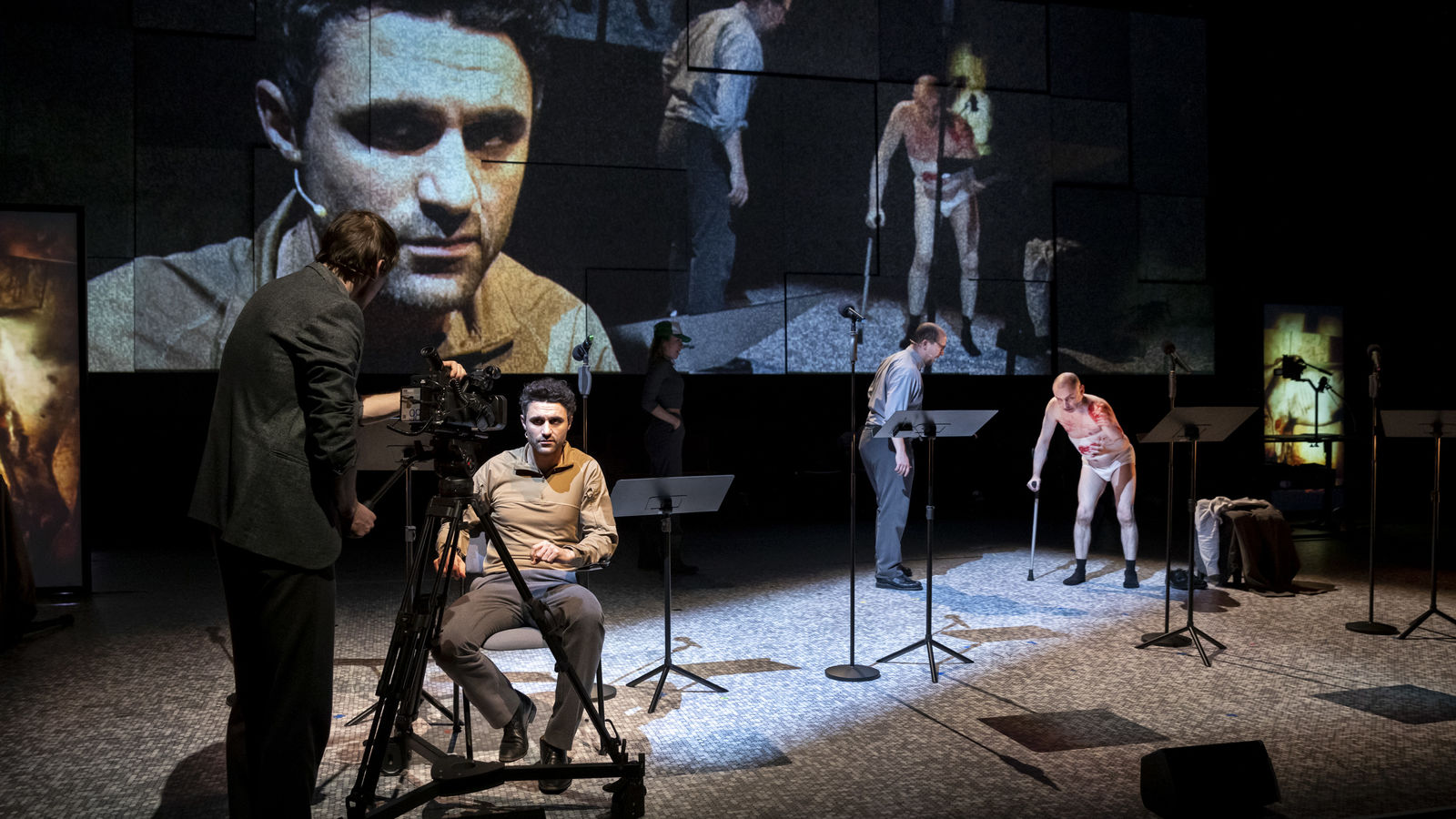


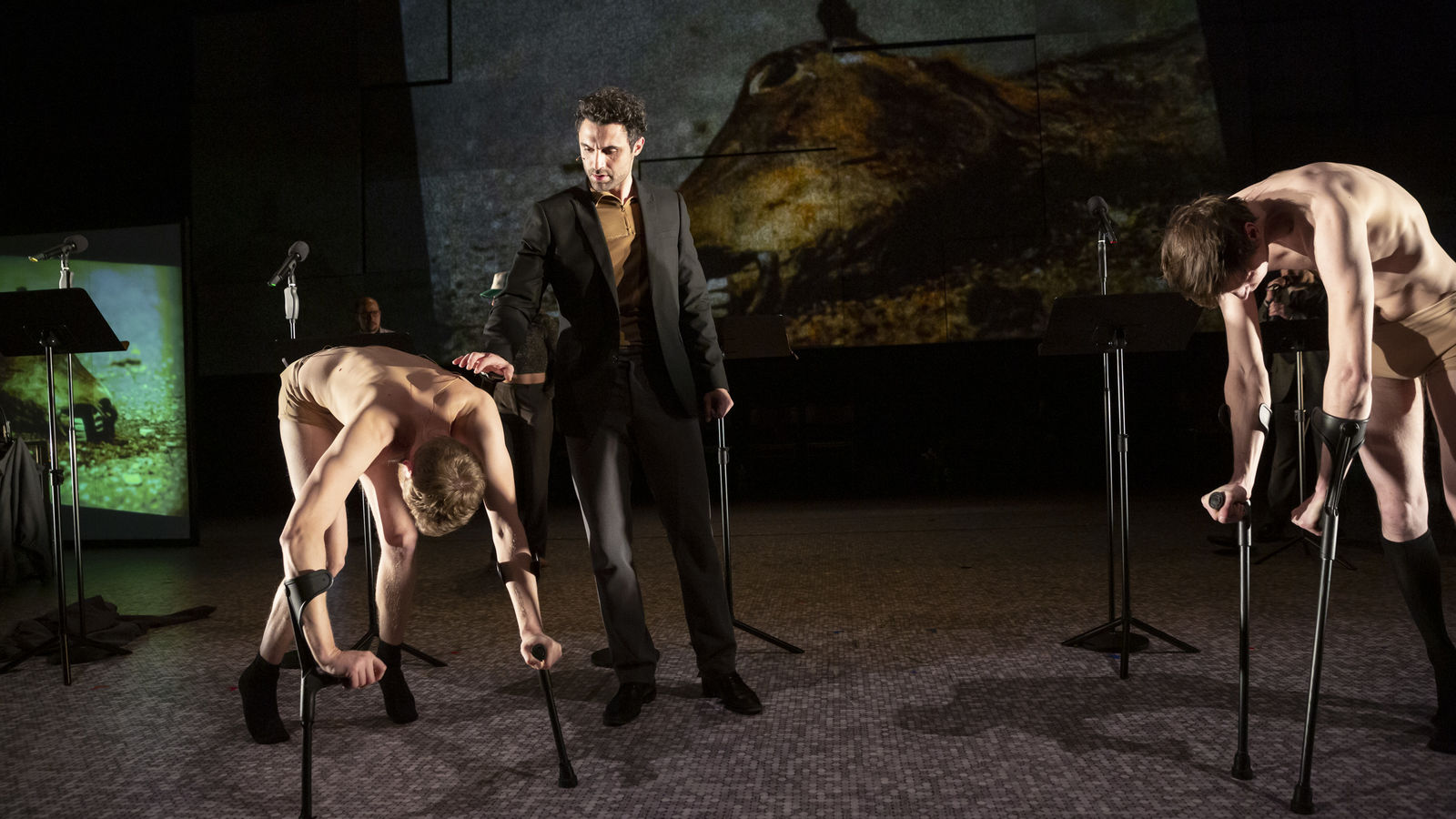
A Reply to Distancing, with »Michael Kohlhaas«
By Joseph Pearson
18 November 2020
I see the actors––tested regularly––unmasked on stage. It’s a rehearsal of Heinrich von Kleist’s »Michael Kohlhaas« at the Schaubühne. They stand close, wrap around each other, share the same air. One touches the other’s face. The video focuses on the gesture. As the production plays with intimacy, it creates a longing for different times.
»Touch is incredibly important for this production«, director Simon McBurney tells me, »And the way that people experience touch is, of course, heightened as a consequence of Coronavirus«.
»I miss the easiness of touch«, I reply.
»Aren’t we lucky?« smiles co-director Annabel Arden, his long-time collaborator and co-founder of Complicité. She looks to the stage, »It is important to say how much the audience means to us, and how we assert the human need to gather and listen together«.
Around the Schaubühne, things are not as usual: a month of performances has been cancelled, the café is shuttered, signs on the glass doors say »closed«. I feel like I am breaking into the building as I wander past the warnings and the dispensers for disinfectant and am observed by the designated »Corona Officers« who evaluate hygienic measures. The practice stage is limited by number of occupants. I sit with a respirator mask in a chair in the corner. The company are working so hard, without the knowledge that they will be able to premiere as planned in December. Already, Thomas Ostermeier’s »Vernon Subutex I« has been delayed for the second time because of the epidemic.
McBurney is a familiar presence at the Schaubühne. I first interviewed him during FIND 2015 for his work-in-progress »Amazon Beaming«. McBurney returned the next year to work with the ensemble on Stefan Zweig’s »Beware of Pity«. German-language literature is again the theme with Kleist. There are continuities between these productions: innovative and delicate sound design (»Amazon Beaming« had the whole audience wearing headsets), an experimental approach to character (the actors share and blur identities), a playful mix of staged reading, dramatic performance and video projection.
The minimal set today is dominated by an enormous screen behind the stage, and two smaller ones to the sides. Otherwise, I only see during this rehearsal a few chairs and props. The richness comes from the actors’ gestures and the projections: early modern portraits of Junkers, the bodies of horses, historical scenes from the world of Kleist’s novella.
McBurney reflects: »The set reflects the world of Michael Kohlhaas. When he suffers an injustice, the order of things is disturbed, and his world begins to separate into fragments. The austerity, if you like, of the book is reflected in the austerity of the set, and its images of fragmentation, of shattering. By removing everything, everything is in the here and now. This is just as it has to be in this moment, performing in a moment of Coronavirus, in the chaos of the world. COVID heightens a sense of separation, but it is a part of the society we inhabit. Most of the time we don’t pay attention to this distancing, and then suddenly we realise how deeply divided we are one from one other and from nature. The fact that the set is completely bare is also, it seems to me, highly appropriate to the nature of this story and the nature of our time as we try to piece together all sorts of different fragments and turn them into a coherent whole«.
I ask McBurney what »the whole« might be.
He looks to continuities: »The story should, I hope, link us back in time to Kleist. Kleist himself leaps himself over 250 years to Michael Kohlhaas, to say that we are in continuity with the past. The past is not a separate thing from us, which is how we tend to think of it. Just as nature is not. Telling the story, and telling it now––finding the means to tell it––is also an act of conjunction, certainly an attempt at that. It is not only a way of bringing the story alive but also to feel the spirit of the man who wrote the story. We thereby join that time with this time, just as he joined the previous time with his own«.
»Is Covid an opportunity, or a moment for reflection, to redress these separations?«
»In theory, it’s an opportunity to begin again. But not everyone is doing that. We talk about going »back to normal«, but you can’t go back. Time and space go forward, and so, we are not able to go backward. And so, the question is what kind of forwards do we go into?«
»Michael Kohlhaas«, written by Kleist in 1810, is based on the real hardships of a 16th-century horse trader. A nobleman wrongs Kohlhaas by detaining and starving his horses and using his influence in the court to prevent the man from seeking justice. After Kohlhaas’s wife enters the spat and pays with her life, the trader wages war on his enemies, burning their properties, cities, and demanding justice.
The path from the early 19th-century novella to the stage is not a straightforward one. It is not easy to tell a story on stage that roams between castles and cities, over great distances in early modern Europe. But language, unexpectedly, is even more of a challenge. Reading Kohlhaas in German, one observes how knotty it is. But a reader of translations by Martin Greenberg––or the newer one by Michael Hofmann for that matter––will be surprised by the simplification of the unwieldy mouthfuls of prose in English.
Playwright Maja Zade, dramaturge on the production, explains, that »the language in Kohlhaas is very forensic and detailed. There’s not a great deal of description of people’s motives or feelings. The sentences usually have several subclauses, and often subclauses within subclauses, and sometimes a sentence changes direction halfway through and goes down a different path from how it started. So, you have to spend a good deal of time trying to figure out what the sentence actually means before you can then try to speak it in a way that will make sense to an audience«.
McBurney reflects, »I’m humbled by the work, and working with it in the original at the Schaubühne. Kleist deliberately employs an unemotional, distanced, style but one that also has incredible speed and inevitability and power. This is exemplified in the very opening sentence of the whole novella:
An den Ufern der Havel lebte, um die Mitte des sechzehnten Jahrhunderts, ein Roßhändler, namens Michael Kohlhaas, Sohn eines Schulmeisters, einer der rechtschaffensten zugleich und entsetzlichsten Menschen seiner Zeit.
On the banks of the River Havel, in the middle of the 16th century, there lived a horse dealer by the name of Michael Kohlhaas, son of a schoolmaster, at once one of the most righteous and terrible men of his day.
»Everything unfolds from that paradox, which is, in a sense, a mythical human paradox. We can be righteous but we are also terrible. Everything tumbles from that. The style, with its multiple sub-clauses and vast single sentences, almost sculpts the situations with words. He uses words like clay or bricks or scaffolding. Then, we must situate ourselves within that construction rather than imagining we are this person because we identify with a particular voice, sinking into it in a fuzzy and emotional way because we sympathise. Here, it is much more demanding and more austere and even strangely absurd«.
»Thinking about the moral issues in the text. Is Kohlhaas fighting for the greater good or is he a petty rogue? Is violence an appropriate path forward when the State cannot deliver justice?« I ask.
»The question how you manage to get justice is very complex. The basic premise is that this man, Michael Kohlhaas, who completely believes in society, discovers that the world has changed for him. Everything begins to unravel bit by bit. The world is not necessarily ordered but disordered. A very simple and tiny disorder can ultimately lead to extraordinary disorder. Human beings try to bring order within the chaos. They have something called law and justice and these are systems we believe in. But we are reminded of constantly that they are human constructs and not eternal absolutes and, once they are disturbed, can unravel completely. Out of the chaos can rise many different things: whether it is Donald Trump, or ISIS, or all sorts of extremism. What we assume is right and balanced and possible are all suddenly called into question. We see perhaps, at that point, the limitations of being human: the frailty, the weaknesses, the fact that these are all human narratives. They are not eternal laws«.
»How then do we evaluate his response to this disintegration?«
»Ultimately, Michael Kohlhaas’s response to injustice is violence. That is the only way that he can conceive of righting a wrong. He can’t see any other possibility. He justifies it because he sees himself as a moral man: because society has not allowed him to get justice within the laws of society. He, therefore, at that point, becomes an outcast and––once outside society––has the moral right to choose how he wants to behave. Now, there is another way of behaving. If you wanted to gender the subject, you could say this recourse to violence is a fundamentally masculine response. What is interesting is that there is another way: that is, resistance through non-violence, as in the case of somebody like Chelsea Manning, who exposes the injustice of what happens but then accepts immediately whatever punishment comes with that. But the resistance to injustice is equally strong in both the case of Kohlhaas and Manning«.
»What other individuals have inspired your narrative? What do their responses mean for our times?«
»Another exposure to injustice is someone like Ed Snowden. Other people who resist injustice include, for example, Ken Saro-Wiwa in Nigeria, who died for his beliefs. Equally, you can point to contemporary figures, Arundhati Roy, or organisations combatting climate injustice like Extinction Rebellion. All of these people are challenging conventional narratives. Constantly, the response of the conventional narrative is that there are proper channels to go through. We are government; you need to go through government. But the question––which is at the heart of »Michael Kohlhaas«––is yes, but will that change anything? His example is: it will only change if I make it change. If we are the change. In other words: be the change! We have to be the change«.
Michael Kohlhaas
by Heinrich von Kleist
In a version by Simon McBurney, Annabel Arden, Maja Zade and the ensemble
Director: Simon McBurney and Annabel Arden
Premiered on 1 July 2021
Mit dem Aufruf des Videos erklären Sie sich einverstanden, dass Ihre Daten an YouTube übermittelt werden. Mehr dazu finden Sie in unserer Datenschutzerklärung.
Bei Klick auf die Schaltfläche "Akzeptieren" wird ein Cookie auf Ihrem Computer abgelegt, so dass Sie für die Dauer einer Stunde, diese Meldung nicht mehr angezeigt bekommen.
Pearson’s Preview

Archive
March 2017
Poetry that Smashes Our Comfort. Angélica Liddell’s »Dead Dog at Dry Cleaners: the Strong«
December 2016
Professor Bernhardi: Bullying, Intrigue, and Survival
December 2016
Katharina Ziemke: Paintings that Illuminate Themselves
October 2016
Dreaming Camus’ Stranger
September 2016
»Empire« on and off-stage: A Conversation with Milo Rau
| Page 6 of 10 pages |
